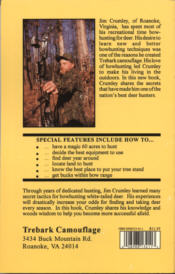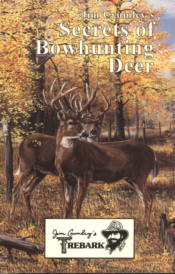
|
Features
|
|
|
|
Book Selections
|
|
Fun & Games
|
|
Contact Us
|
| Click on Images to Enlarge |
 |
CHAPTER 7
SCOUTING DURING THE SEASON
I begin my scouting for the middle of deer season when I'm hunting the early season.
LOOK FOR SCRAPE LINES AND RUBS
On my way to and from my tree stand, I look for old scrape lines and new rubs. If I see a rub, I notice how big the tree is the deer's rubbing, how high the rub is off the ground, and what type of tree the deer has used to rub up against. Most hunters and wildlife biologists generally agree that bigger bucks usually will rub bigger trees that offer more resistance than trees young bucks rub. By looking at the size of trees the deer are rubbing, you can begin to develop an idea about the size of the bucks available on the property you're hunting.
I've also determined that bigger bucks generally rub higher up on the tree than younger bucks will. If you'll locate and watch old scrape lines, often you'll see these old scrapes being used by bucks as the rut begins. Even though I'm not going to commit a stand to these rubs or these old scrape lines at the beginning of the season, I'll still make a mental note to check these areas in the middle of the season. Then, I can put a stand there if the buck activity seems to have increased in these regions.
SEARCH FOR OTHER DEER SIGN
If I'm not seeing as many deer a week or two into the season as I have been at the first week of the season, then I'll get out of my tree stand in the late morning and scout. In the middle of the season, I'll walk through the woods quite a bit, midday, although I know I'm leaving plenty of human odor. But walking through the woods and studying the signs the deer are leaving are the only ways I can tell when the deer change their feeding habits, start to rut or alter their movement patterns. Therefore, I'm willing to sacrifice notifying the deer that I'm in the woods hunting them. I want to be able to understand where the deer are, when they're moving, and most importantly, where they're moving to.
I'll also go into other areas on the property during the middle of the season that I haven't seen since the first time I scouted the property. I'll be looking for deer sign and trying to determine how, where and when the deer are moving in these regions since I've seen them last.
IDENTIFY WHERE THE DEER ARE EACH WEEK
Often a bowhunter is reluctant to give up a stand that's been productive in the first part of the season just because he's seen or taken deer in that stand before. However, when the deer deplete the food source that has made that stand productive or hunting pressure has caused bucks to avoid that stand site, then the quicker you can stop hunting the area you have been hunting and search for new regions the deer are now using, the greater your chances for success will be.
After the first week or two of bow season in sections where deer experience intense hunting pressure, they often will change the routes they take to and from feeding and bedding areas. When they deplete a food source, they will not return to a place where the food source once has been abundant. When a new preferred food source begins to drop its fruit, then the deer will migrate to that food source. Successful, mid-season hunting depends on your understanding when to leave the area where the deer have been and instead hunt the sites where the deer now will be.
By the middle of the season, you'll also know how much hunting pressure is being exerted where you're hunting. Most bowmen hate to hunt in crowded woods because they believe the more hunters in the woods at one time, the fewer opportunities they will have to take deer. However, if you know how, when and where most bowhunters hunt, you can use that hunting pressure to your advantage.
|
How To Order CALL or Send check or money order to: Night Hawk Publications *All Alaskan orders add $8 for each book ordered. *All Canadian orders add $3 for each book ordered and use International
Money Order |

